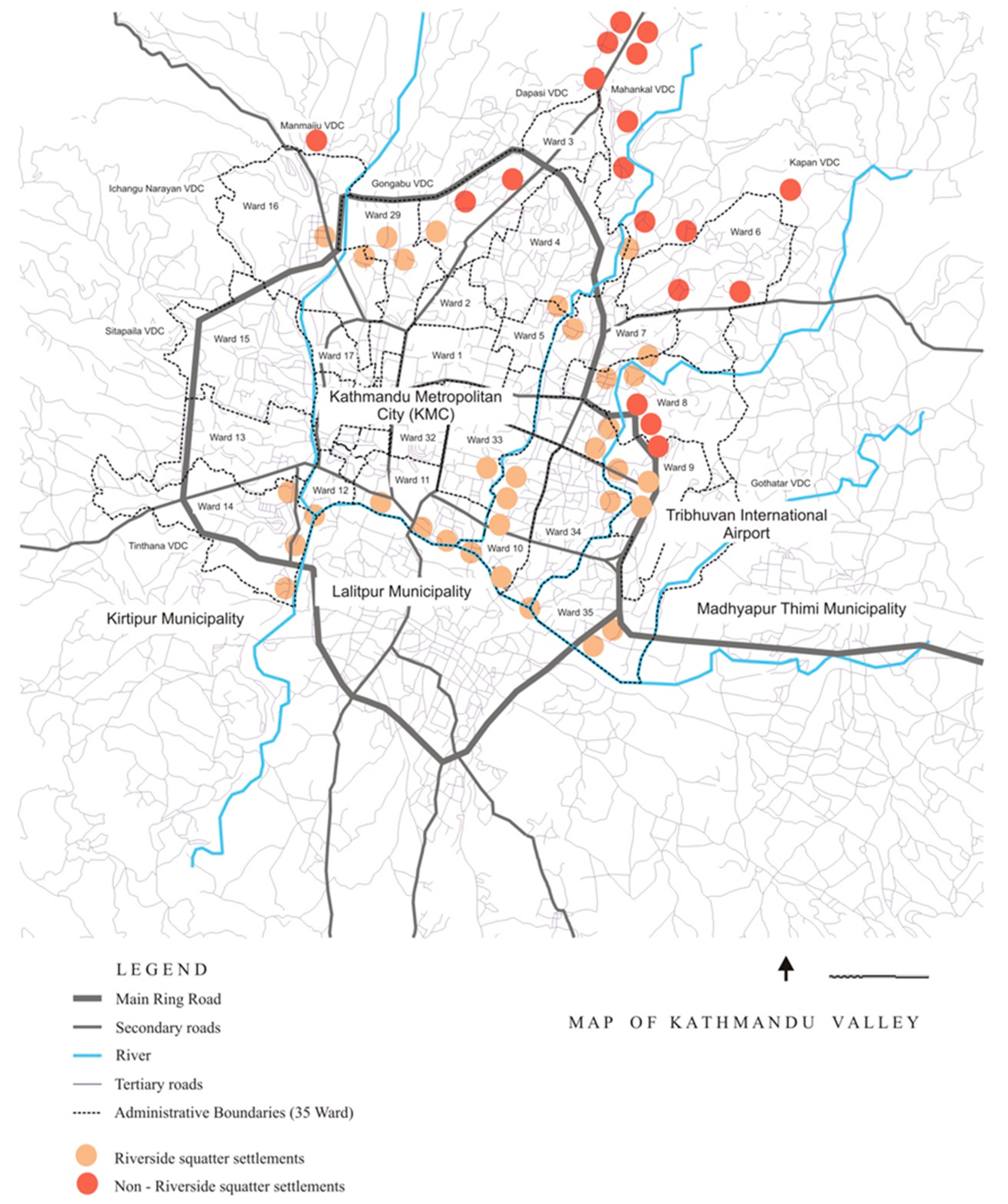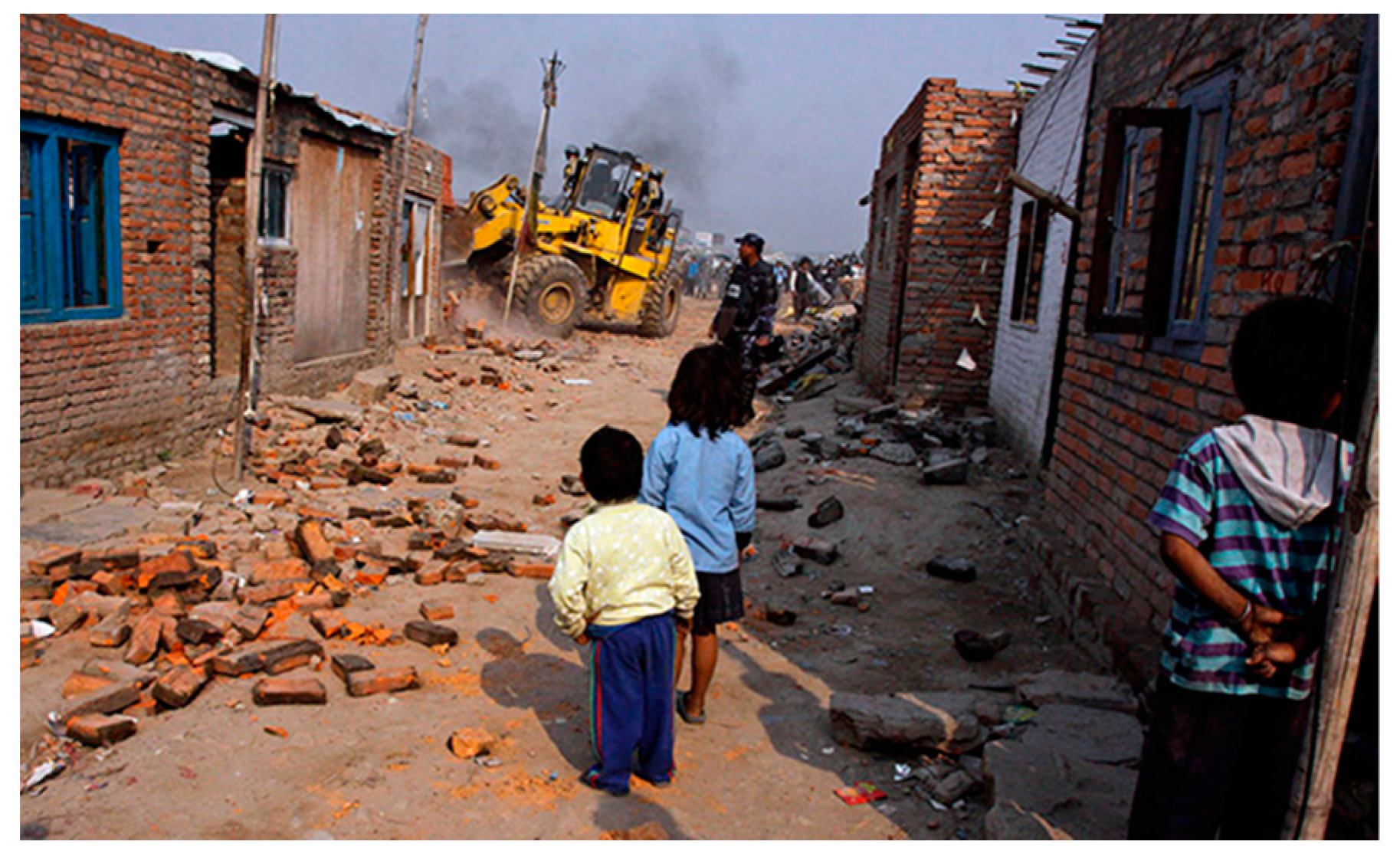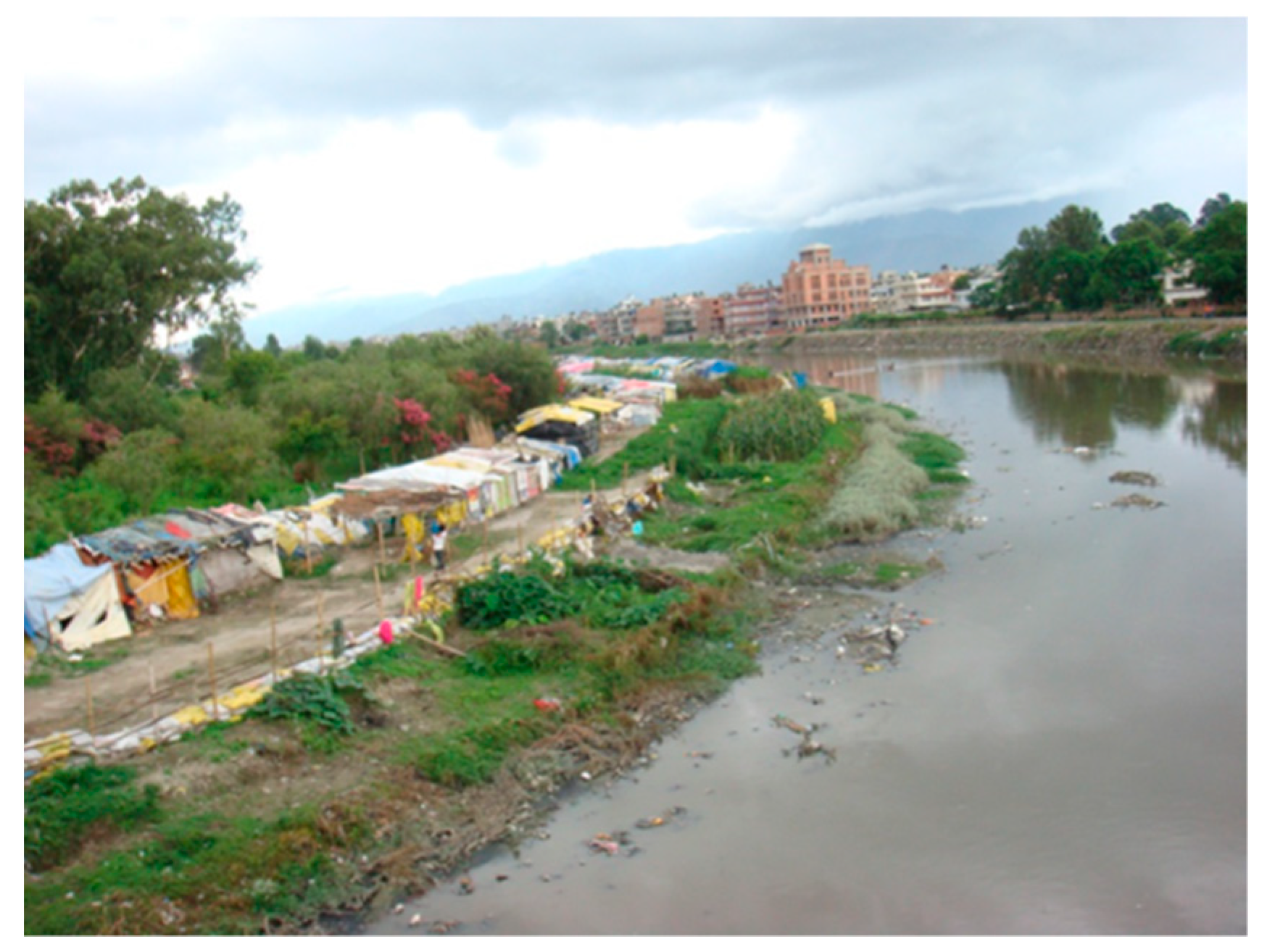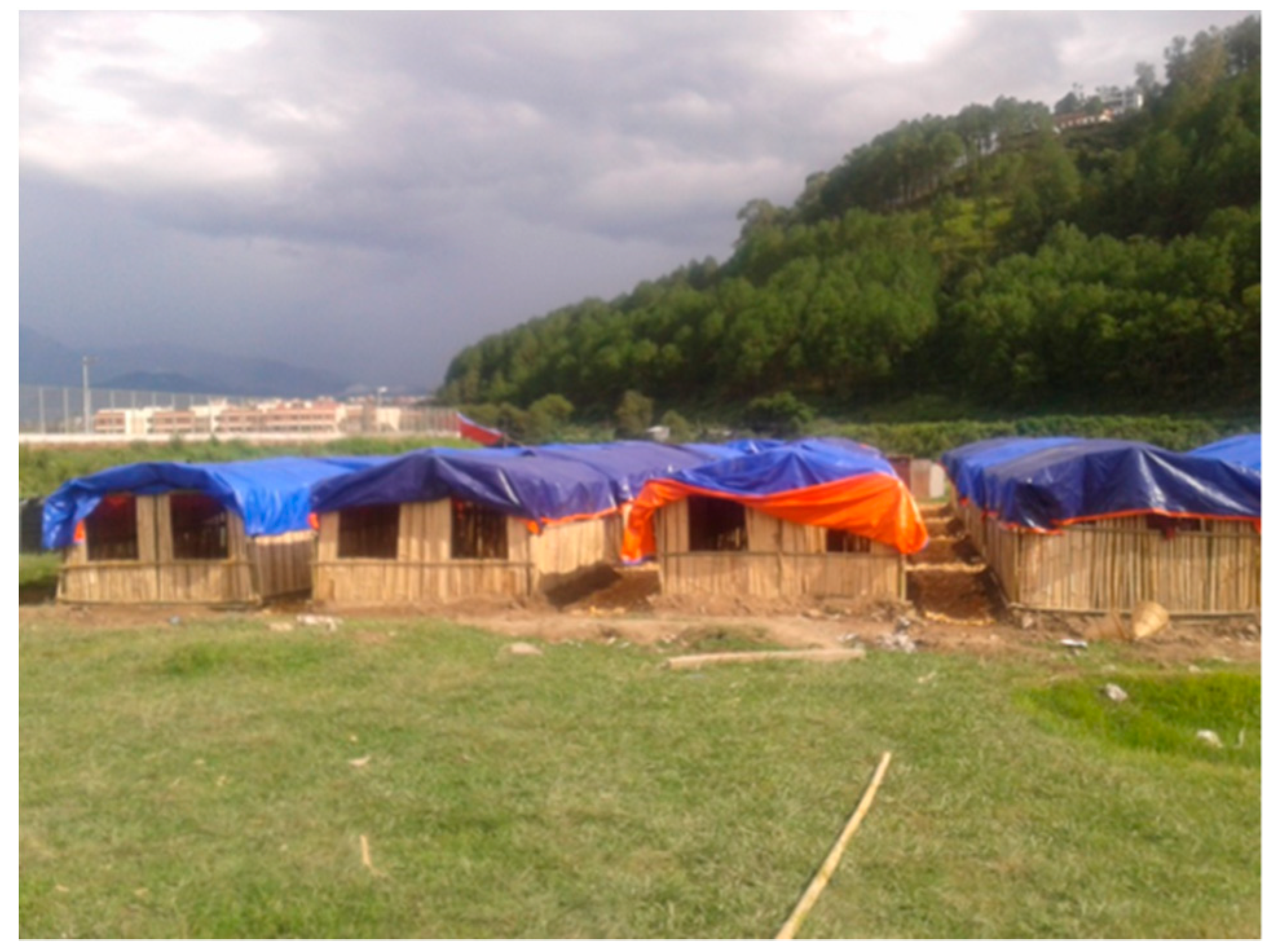Mainstreaming the ‘Brown’ Agenda †
Abstract
:1. Introduction
‘sustainable development is development which meets the needs of the present without compromising the ability of the future generations to meet their own needs.’
2. Theory and Methods
2.1. Sustainable Development: An Oxymoron
‘Environment is what the sustainability advocates have been focusing on historically’.‘Economy within the sustainability rhetoric is the argument that economic growth is a prerequisite to tackle externalities and adversities of growth’.‘Equity is aimed at including all actors at grassroot level in a process of discourse and dialogue, engage them in conflict mitigation and consensus building and eventually leading to decision-making’.
2.2. Methods
- Conversations (a number of squatter households)
- Semi-structured interviews (five government officials and 48 squatter households)
- In-depth stories (six in-depth life stories)
- Focus group discussions (five focus group discussions with local Non – Government Organizations (NGOs), Community Based Organizations (CBOs), grassroot squatter organizations, etc.)
- Baseline survey (detailed baseline survey for all three squatter settlements)
- Direct observations (all the three squatter settlements)
- Reports (policy documents, National Shelter Policy, etc.)
- Seminars (planning seminars and others organized by grassroot squatter organizations)
- Newspaper clippings
- Cadastre maps
3. Case
3.1. Context
3.2. The ‘Green’ Agenda: Ecological Sustainability of the Bagmati River
- construction of trunk sewer pipeline along both sides of the river
- construction of secondary sewer pipelines
- construction of wastewater treatment plants
- construction of river training works
- construction of roads and green belts along the banks of the river, and
- public awareness programs
3.3. The ‘Brown’ Agenda: Eviction of Informal Housing along the Riverbanks
4. Discussion
4.1. ‘Sustainability of What?’ and ‘Who Decides?’
4.2. Governance and Socio-Economic Equity
‘…a criterion for motivated and transparent administration as well as efficient, flexible and equal service provision and resource allocation’.
5. Conclusions
‘Sustainable development is development that meets specific needs of the present and can be maintained into the future, without detracting from satisfaction of other needs in the present or future’.
Funding
Acknowledgments
Conflicts of Interest
References
- McGranahan, G.; Satterthwaite, D. Urban centers: An assessment of sustainability. Ann. Rev. Environ. Resour. 2003, 28, 243–274. [Google Scholar] [CrossRef]
- World Commission of Environment and Development (WCED). Our Common Future; Oxford University Press: Oxford, UK, 1987; p. 43. [Google Scholar]
- Allen, A.; You, N. Sustainable Urbanisation: Bridging the Green and Brown Agendas; UN-HABITAT: Nairobi, Kenya, 2002. [Google Scholar]
- Redclift, M. Sustainable development (1987–2005): An oxymoron comes of age. Sustain. Dev. 2005, 13, 212–227. [Google Scholar] [CrossRef]
- Adams, B. Green Development: Environment and Sustainability in a Developing World; Routledge: Abingdon, UK, 2008. [Google Scholar]
- Beckerman, W. ‘Sustainable development’: Is it a useful concept? Environ. Values 1994, 3, 191–209. [Google Scholar] [CrossRef]
- Redclift, M. Sustainable Development: Exploring the Contradictions; Routledge: London, UK, 1987. [Google Scholar]
- Redclift, M. Sustainable development: Needs, values, rights. Environ. Values 1993, 2, 3–20. [Google Scholar] [CrossRef]
- Dobson, A. Justice and the Environment; Oxford University Press: Oxford, UK, 1998. [Google Scholar]
- Miller, D. Social Justice and environmental goods. In Fairness and Futurity; Dobson, A., Ed.; Oxford University Press: Oxford, UK, 1998. [Google Scholar]
- Tarafdar, A.K. Bridging the Dichotomy: Exploring Linkages between Urban Environmental Challenges and Local Development Practices in the Neighbourhood of Kolkata, India. Ph. D. Thesis, NTNU, Taibei, Taiwan, 2010. [Google Scholar]
- Spaiser, V.; Ranganathan, S.; Swain, R.B.; Sumpter, D.J. The sustainable development oxymoron: Quantifying and modelling the incompatibility of sustainable development goals. Int. J. Sustain. Dev. World Ecol. 2017, 24, 457–470. [Google Scholar] [CrossRef]
- Bartone, C.; Bernstein, J.; Leitmann, J.; Eigen, J. Towards Environmental Strategies for Cities, Policy Consideration for Urban Environment Management in Developing Countries; UMP; World Bank: Washington, DC, USA, 1994; p. 18. [Google Scholar]
- McGranahan, G.; Satterwaithe, D. Environmental health or ecological sustainability? Reconciling the Brown and Green agendas in urban development. In Sustainable Cities in Developing Countries; Pugh, C., Ed.; Earthscan: London, UK, 2000; pp. 73–90. [Google Scholar]
- Dupont, V. Conflicting stakes and governance in the peripheries of large metropolis–An introduction. Cities 2007, 24, 89–94. [Google Scholar] [CrossRef]
- UN DESA. World Urbanization Prospects: 2014 Revision; United Nations Department of Economic and Social Affairs: New York, NY, USA, 2014. [Google Scholar]
- CBS. National Population and Housing Census 2011: National Report; Central Bureau of Statistics, Government of Nepal: Kathmandu, Nepal, 2012.
- Muzzini, E.; Aparicio, G. Urban Growth and Spatial Transition in Nepal; World Bank: Washington, DC, USA, 2013. [Google Scholar]
- MoUD. National Urban Development Strategy 2015; Ministry of Urban Development, Government of Nepal: Kathmandu, Nepal, 2015.
- Thapa, R.B.; Murayama, Y.; Ale, S. Kathmandu. Cities 2008, 25, 45–57. [Google Scholar]
- CBS. National Population and Housing Census 2011: Urban Tables; Central Bureau of Statistics, Government of Nepal: Kathmandu, Nepal, 2014.
- Adhikari, A.P. Urban and Environmental Planning in Nepal: Analysis, Policies and Proposals; IUCN: Kathmandu, Nepal, 1998. [Google Scholar]
- Regmi, M.C. Landownership in Nepal; Adroit Publishers: Delhi, India, 1999. [Google Scholar]
- Pokharel, J. A Policy on Urban Housing in Nepal, Policy Paper 26; Economic Policy Network: Kathmandu, Nepal; Government of Nepal/Ministry of Finance: Kathmandu, Nepal; Asian Development Bank: Kathmandu, Nepal; Nepal Resident Mission: Kathmandu, Nepal, 2006.
- Gallagher, K.M. Squatting in the Kathmandu Valley: A historical perspective. Contrib. Nepal. Stud. 1992, 19, 249–259. [Google Scholar]
- Rademacher, A. When Housing an Environmental Problem? Reforming Informality in Kathmandu. Curr. Anthropol. 2009, 50, 513–533. [Google Scholar] [CrossRef]
- DUDBC. Department of Urban Development and Building Construction’s Report on Squatter Settlements in Kathmandu Valley; DUDBC: Kathmandu, Nepal, 2010. [Google Scholar]
- Ghimire, K. Forest or Farm? In The Politics of Poverty and Land Hunger in Nepal; Oxford University Press: Oxford, UK, 1992. [Google Scholar]
- Hada, J. Housing and squatter settlements. In City Diagnostic Report for City Development Strategy; Kathmandu Metropolitan City: Kathmandu, Nepal; World Bank: Kathmandu, Nepal, 2001; pp. 135–190. [Google Scholar]
- Ministry of Urban Development. National Shelter Policy; Government of Nepal: Kathmandu, Nepal; Bara Offset Press: Kathmandu, Nepal, 2012.
- BAP. Bagmati Action Plan. In High Powered Committee for Integration Development of the Bagmati Civilization: National Trust for Nature Conservation; Government of Nepal: Kathmandu, Nepal, 2009. [Google Scholar]
- Myllylä, S.; Kuvaja, K. Societal premises for sustainable development in large southern cities. Glob. Environ. Chang. 2005, 15, 224–237. [Google Scholar] [CrossRef]
- Leitmann, J. Sustaining Cities. Environmental Planning and Management in Urban Design; McGraw-Hill: New York, NY, USA, 1999. [Google Scholar]
- Marcuse, P. Sustainability is not enough. Environ. Urban. 1998, 10, 103–111. [Google Scholar] [CrossRef]
- Niemela, J. Ecology and urban planning. Biodivers. Conserv. 1999, 8, 119–131. [Google Scholar] [CrossRef]





| S.no | Name of Squatter Eviction | Year | Reason for Eviction |
|---|---|---|---|
| 1 | Paroprakar eviction | 1995 | Government’s plan for the construction of a park which was to serve the purpose of a green belt along the riverside |
| 2 | Bagmati riverside eviction | 2002 | Government’s plan to heighten security for the South Asian Association for Regional Cooperation (SAARC) summit to be held in the capital |
| 3 | Bishnumati link road eviction | 2003 | Construction of Bishnumati link road |
| 4 | Thapathali eviction | 2012 | As part of the government’s plan to clean-up Bagmati River |
© 2019 by the author. Licensee MDPI, Basel, Switzerland. This article is an open access article distributed under the terms and conditions of the Creative Commons Attribution (CC BY) license (http://creativecommons.org/licenses/by/4.0/).
Share and Cite
Shrestha, P. Mainstreaming the ‘Brown’ Agenda. Sustainability 2019, 11, 6660. https://doi.org/10.3390/su11236660
Shrestha P. Mainstreaming the ‘Brown’ Agenda. Sustainability. 2019; 11(23):6660. https://doi.org/10.3390/su11236660
Chicago/Turabian StyleShrestha, Pranita. 2019. "Mainstreaming the ‘Brown’ Agenda" Sustainability 11, no. 23: 6660. https://doi.org/10.3390/su11236660
APA StyleShrestha, P. (2019). Mainstreaming the ‘Brown’ Agenda. Sustainability, 11(23), 6660. https://doi.org/10.3390/su11236660





